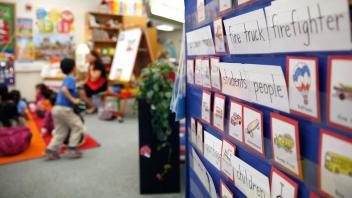Indirect vocabulary learning refers to students learning vocabulary when they hear and see words through conversations with adults, through being read to, and through reading on their own.
Direct vocabulary learning refers to students learning vocabulary through explicit instruction in both individual words and word-learning strategies. Direct vocabulary instruction aids in reading comprehension. Two examples of direct vocabulary instruction include: specific word instruction and word learning instruction.
Indirect vocabulary learning
Children learn the meanings of most words indirectly, through everyday experiences with oral and written language.
Children learn word meanings indirectly in three ways:
- They engage daily in oral language
Young children learn word meanings through conversations with other people, especially adults. As they engage in these conversations, children often hear adults repeat words several times. They also may hear adults use new and interesting words. The more oral language experiences children have, the more word meanings they learn.
- They listen to adults read to them
Children learn word meanings from listening to adults read to them. Reading aloud is particularly helpful when the reader pauses during reading to define an unfamiliar word and, after reading, engages the child in a conversation about the book. Conversations about books help children to learn new words and concepts and to relate them to their prior knowledge and experience.
- They read extensively on their own.
Children learn many new words by reading extensively on their own. The more children read on their own, the more words they encounter and the more word meanings they learn.
Direct vocabulary learning
Although a great deal of vocabulary is learned indirectly, some vocabulary should be taught directly. Direct instruction helps students learn difficult words, such as words that represent complex concepts that are not part of the students’ everyday experiences. Direct instruction of vocabulary relevant to a given text leads to a better reading comprehension.
Direct instruction includes providing students with specific word instruction and teaching students word-learning strategies.
In particular:
- Teaching specific words before reading helps both vocabulary learning and reading comprehension.
Before students read a text, it is helpful to teach them specific words they will see in the text. Teaching important vocabulary before reading can help students both learn new words and comprehend the text.
- Providing instruction over an extended period of time encourages students to use vocabulary in different contexts – both in spoken and written communication.
Children learn words best when they are provided with instruction over an extended period of time and when that instruction has them work actively with the words. The more students use new words and the more they use them in different contexts, the more likely they are to learn the words.
- Repeated exposure to vocabulary in many contexts aids word learning.
Students learn new words better when they encounter them often and in various contexts. The more children see, hear, and work with specific words, the better they seem to learn them. When teachers provide extended instruction that promotes active engagement, they give students repeated exposure to new words. When the students read those same words in their texts, they increase their exposure to the new words.
Adapted from: Put Reading First: The Research Building Blocks for Teaching Children to Read, 2001, a publication of The Partnership for Reading.
